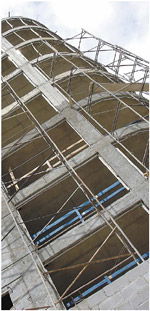EACH YEAR, people are killed or seriously injured by electricity in the construction industry. Most of these accidents could be avoided.

Construction sites present one of the most difficult environments for the safe use of electricity because:
- work is often performed outdoors in all weathers meaning electrical equipment may be subject to damp or wet conditions
- sites change as work progresses meaning electrical equipment can suffer damage
- a mains electricity supply may not be available. There is always a risk of improvisation
- cables can suffer damage due to equipment movement
- there may be a reluctance to provide proper earthing.
Effective management is essential to avoid injury
A small generator is considered to be one that has an output from 0.3 to 10 kVA and such a machine is generally single-phase, portable or transportable and provides an output at 230 V and/or 120 V. Winding connections are normally brought out to a three-pin socket-outlet which should conform to BS EN 60309-2 in which the third or protective conductor socket tube is connected to the generator enclosure. In some cases the protective conductor socket tube will also be connected to one pole of the generator winding. A voltage-selector switch may be fitted to enable 230 V or 120 V outputs to be obtained from appropriate BS EN 60309-2 socket-outlets.
A small single-phase generator is often run as a floating system. A means of earthing is not required. In such a system the generator is deliberately not connected to external metallic parts nor is one pole of the single-phase electrical system connected to earth.
In such a system there is no path for an earth fault current to return to the 'separated' winding of the generator. Safety must be ensured by meeting the following conditions:
(a) The generator should be used only on a short term basis (for a maximum of a few days, but ideally, less than one day).
(b) The generator should preferably supply only one item of Class II equipment (See figure 1). Hand-held 110 V (industrial use) or 230 V (domestic use) portable equipment should be Class II construction.
To read full article please download attachment...
(article extracted from IET, Wiring Matters, Autumn 06)
